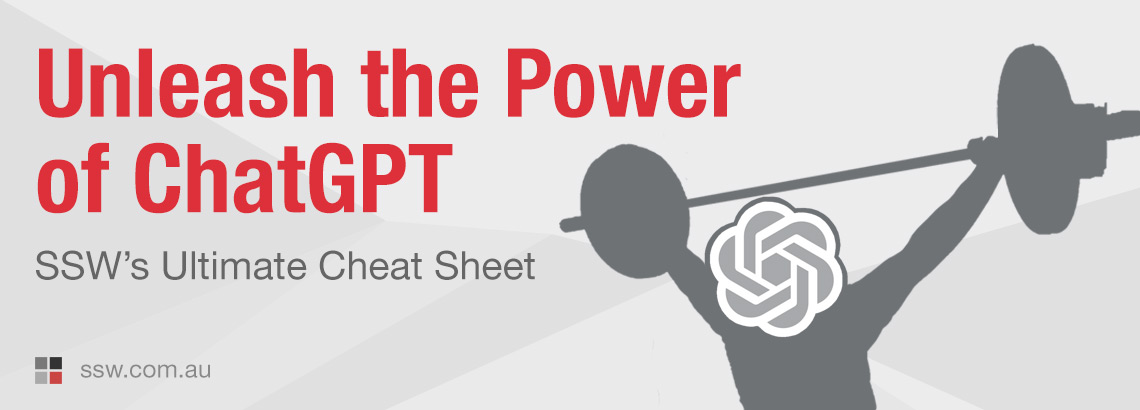Unleash the Power of ChatGPT – SSW’s Ultimate Cheat Sheet
Why use ChatGPT
I love ChatGPT, I use it every day to help me both at home and at work. It’s great at things like checking emails, drafting notes, and doing initial research. My kids are using it too for everything from assignments, to finding recipes with what’s left in the fridge. At SSW we’ve really embraced it, and have a group called “ChatGPT Power Users” looking for ways to use ChatGPT to make us more efficient.
We’ve created a comprehensive ChatGPT Cheat Sheet to help you get the most out of your AI experience. This cheat sheet is filled with tips, tricks, and examples to maximize your AI interactions and spark new ideas. Let’s dive in and explore some highlights from our ChatGPT Cheat Sheet!
Things it can do:
🤖 Content Understanding – ChatGPT can assist in better understanding and reacting to everyday information by summarizing text, distilling it to main points, finding action points, debating ideas, fact-checking, assessing the urgency of text, and providing counter arguments
🤖 Chatbots – ChatGPT can be integrated with chatbots to create intelligent and responsive conversational interfaces that can help businesses automate customer support, improve user engagement, and reduce operational costs
🤖 Content creation – ChatGPT can be used to generate high-quality, human-like content, such as articles, social media posts, product descriptions, and more. This can be especially useful for businesses that need to produce large volumes of content quickly and consistently
🤖 Language translation – ChatGPT can also be used for language translation. By training the model in multiple languages, it can accurately translate text from one language to another in real-time, making it a useful tool for international businesses and global communication
🤖 Research and data analysis – ChatGPT can be used to analyze large volumes of text data, such as customer feedback, social media conversations, and market research reports. It can quickly identify trends and patterns in the data, enabling businesses to make informed decisions based on insights
Overall, ChatGPT is a powerful tool that we all need to get a good handle on so we can automate tasks, improve communication, and generate valuable insights from our data.
Getting started!
SSW has made getting started with ChatGPT super easy. We took all of the feedback from our team and AI experts and created a cool cheat sheet that shows you the best prompts.
Check out our cheat sheet and try it for yourself, but always remember – do not put anything confidential into Chat GPT…
ssw.com.au/rules/chatgpt-cheat-sheet/

Get Creative with Roles
One of the most effective ways to use ChatGPT is to assign it specific roles. By providing context through a role, the AI can generate more accurate and relevant responses. Here are a few examples of how you can utilize roles:
- Writing coach: “How can I improve the clarity and impact of this project proposal?”
- GitHub Actions expert: “What’s the best way to set up a CI/CD pipeline using GitHub Actions?”
- C# code reviewer: “Please review this C# code snippet for a new feature implementation”
- Copywriter: “Help me write a catchy headline for our new marketing campaign”
- {{ POSITION }} interviewer: “Act as a UX Designer interviewer and ask me 5 relevant questions”
Master the Art of Prompting
Crafting an effective prompt can make all the difference in the quality of ChatGPT’s responses. Our cheat sheet offers valuable dos and don’ts to optimize your prompts:
- For complex tasks: Encourage the AI to ask questions for context
- Request conciseness or bullet points for a clearer response
- Set the tone for responses – professional, informal, funny
- Avoid leading questions that might anchor the AI
- Don’t share confidential information with ChatGPT
Dissect the Anatomy of a Prompt
Understanding the different components of a prompt can help you craft more effective queries. Consider the following example:
Role – Act as a Software Developer
Result – Create 5 email subjects
Context – The email is to inform all the developers about a UX problem with search
Intent – The goal is to get them to critique my YouTube video
Constraint – Subject < 50 characters.
Leverage Chained Prompting
Chained prompting is a powerful technique that allows you to build a series of prompts to obtain more in-depth information. Here’s an example of how to use chained prompting:
- “Create a guide to AI. Give a headline and teaser.”
[ChatGPT’s response] - “Now create 5 subtopics.”
[ChatGPT’s response] - “Now add 3 AI techniques in each subtopic.”
[ChatGPT’s response] - “Critique your response for usability.”
[ChatGPT’s response]
By chaining your prompts, you can create more detailed, informative, and interactive content with ChatGPT.
ChatGPT Refactoring
I like to really push ChatGPT to test how accurate it is. Try giving ChatGPT some nice clean code and tell it that it’s not. For example, “this code has bugs and needs refactoring”. Despite your leading introduction, ChatGPT will still recognize it as good code if it is readable, clean, and well-architected.
Try intentionally breaking the rules by asking ChatGPT to provide incorrect answers or contradict itself. Doing this can give you a better understanding of ChatGPT’s capabilities and limitations.
Our ChatGPT Cheat Sheet is an excellent resource for new and experienced users alike. Print it out, keep it handy, and let the AI work its magic! And remember, practice makes perfect, so don’t be afraid to experiment with different prompts and techniques. Share your own tips and tricks in the comments below!
Also check out this great video on SSWTV from Calum Simpson to see more practical applications for developers.
https://youtu.be/KIIUVvavJGM

June 14, 2023 @ 1:00 AM
Thanks for this Adam Cogan, I’m definitely going to use it in the future.
-Piers Sinclair
https://ssw.com.au
January 11, 2024 @ 12:04 AM
Thanks for this, really like the cheat sheet diagram. clear and concise
Lloyd Collins
https://ssw.com.au